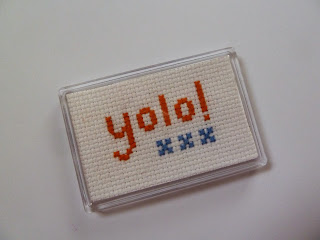The weather has turned and I've felt like making scarfs. I've never been able to understand my motivation. I whipped up a skinny scarf on my new peg loom and as I was explaining just how I did it at knitting group I realised that it would be much easier with pictures. And this tutorial was born.
Skill Level: I'll walk you through it.
Time Taken: A couple of hours. Depends on how long you want it.
Materials:
- one peg loom, we'll be using six pegs here so anything that has more than six.
- something strong for the warp thread: I used a contrasting DK weight cotton here.
- Your funky bulky/super bulky yarn. In this scarf I used 100g of thick and thin hand spun. I made another out of sari silk yarn but as I had less yardage it turned out shorter.
- Scissors
- Darning Needle
All set?
Right, let's cut our warp threads. You want your warp threads to be 2 and 1/2 times the length of your finished objects. I like my scarfs to be the size of my wingspan - about a meter and a half - so I cut them two and a half the size of that. You'll need six of the same length.
Thread your first peg!
And repeat six times.
Now make sure the thread is tied to the bar. The halfway point of your warp threads should be at the peg and the ends are held in place by the bar. Now we're ready to weave.
So tie your pretty yarn around the first peg and go...
front, back, front, back, front, back and repeat
until the pegs fill up.
Now it's time to clear the pegs. Take your first peg and carefully slide it upwards so the yarn gets transferred to the warp.
Carefully slide the second peg out the same way
and repeat until the pegs are clear
and the fluff is hanging out on the warp threads.
Then we need to start filling up the pegs again...
and again and again and again and again until you run out of yarn.
Slide everything down a bit so you have a nice gap and then
Snip it free!
Tie the ends together in pairs. This will leave you with three bits dangleing down which I like to tuck in
by threading on a darning needle and sending them back where they came from.
Then repeat the snip, cut and hide process on the other side.
That's it. Put it on.
This is the one I made from Sari silk. To hold the shorter scarf together I sewed a big button on. The fabric is open enough to pass the button through without needing to make a button hole so it works out perfect. You could also sew the two ends together and go for a cowl if you wanted.
 |
| right, I'm off! |





























































